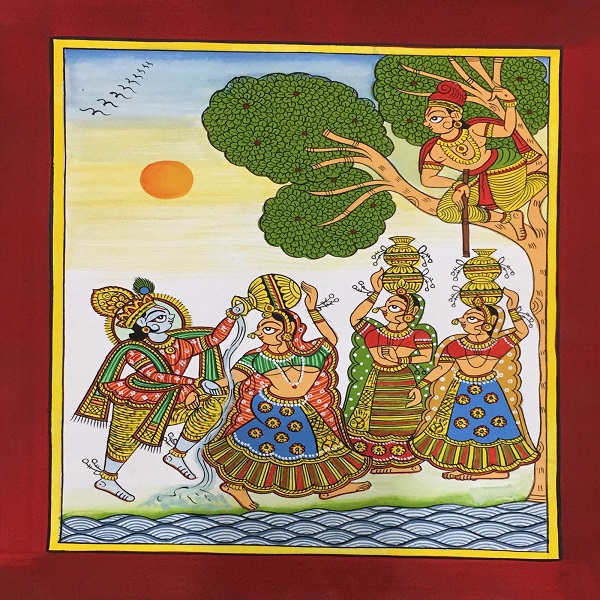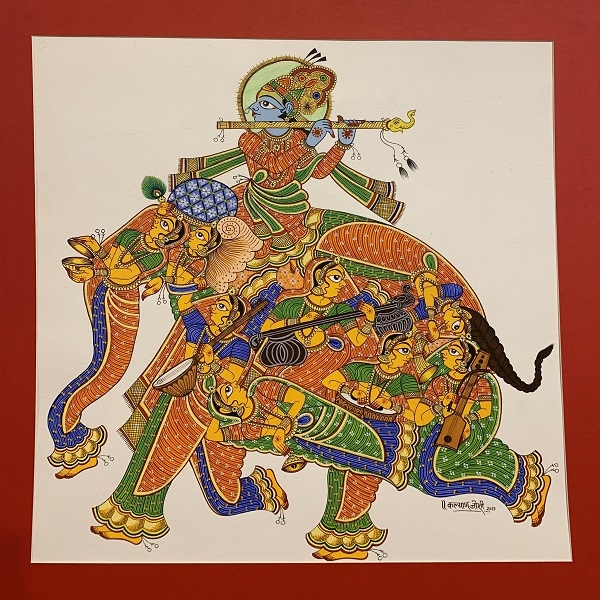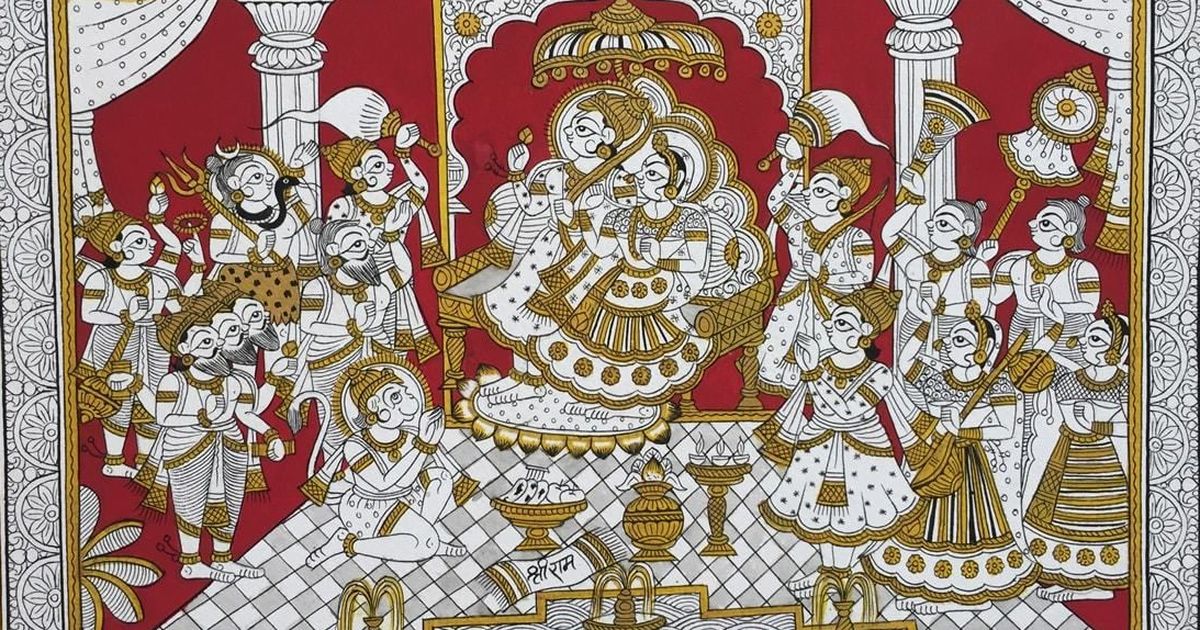ॐ श्री गुरुभ्यो नमः ॐ श्री शिवानन्दाय नमः ॐ श्री चिदानन्दाय नमः ॐ श्री दुर्गायै नमः
Source of all Images in this Blog-post : Google Images : ‘Google Image Search’ will reveal the multiple sources of every single image shared in this Blog. For more details, kindly see ‘Disclaimer‘
Google Images of Rajasthani Phad Paintings : A Visual Feast to the Eyes

Shopping : Buy Phad Paintings Online
Phad painting, also known as Phad, is a style of religious scroll painting and folk painting that originated in the Rajasthan state of India. This distinctive style of painting is traditionally created on a long piece of cloth or canvas known as a Phad, with the narratives of the folk deities of Rajasthan, particularly Pabuji and Devnarayan, depicted in vivid detail.
The intricate and colorful illustrations on these Phads bring to life the tales of the region’s rich cultural heritage, making them an important part of Rajasthan’s artistic and religious traditions.
In Rajasthan, the Bhopas, who are priest-singers, play a significant role in the tradition of Phad painting. They carry the painted Phads with them, using them as mobile temples for the worship of the folk deities that are revered by the Rebari community in the region.
The phads dedicated to Pabuji are usually about 15 feet in length, while those dedicated to Devnarayan are generally about 30 feet long. These intricately painted phads are traditionally created using vegetable colors, which lend them their distinctive earthy hues and add to their cultural and historical significance.
Through their religious and artistic expressions, the Phads of Rajasthan continue to inspire and enchant audiences across the globe.
Google Images of Rajasthani Phad Paintings : A Visual Feast to the Eyes
For over two centuries, the Joshi families of Bhilwara and Shahpura in Rajasthan’s Bhilwara district have been recognized as the traditional artists of Phad painting.
Today, this unique art form is carried forward by a group of highly skilled artists, including Shree Lal Joshi, Nand Kishor Joshi, Pradip Mukherjee, Prakash Joshi, Ghanshyam Joshi and Shanti Lal Joshi.
These artists are widely acclaimed for their creativity and innovative approach to Phad painting, which has helped to revitalize this age-old tradition and bring it to a new generation of art enthusiasts. Through their work, the Joshi families continue to preserve and promote the rich cultural heritage of Rajasthan and the art of Phad painting.
Shopping : Buy Phad Paintings Online
Phad painting, a traditional art form of Rajasthan, includes popular works such as Devnarayan Ki Phad and Pabuji Ki Phad. Shree Lal Joshi and Pradip Mukherjee revolutionized this style about forty years ago. While Mukherjee’s paintings are based on the stories of Ramcharitmanas, Gita Govinda, Kumārasambhava, Bhagavad Gita and Hanuman Chalisa, Joshi’s family has been practicing this art form for the last two centuries.
Initially, the art of Phad painting was exclusively practiced by the Joshi community. However, in 1960, Shree Lal Joshi opened a school called ‘Joshi Kala Kendra’ for everyone to learn this art style. The school is now known as ‘Chitrashala’. Today, artists such as Nand Kishor Joshi, Prakash Joshi, Ghanshyam Joshi and Shanti Lal Joshi are also renowned for their creativity and innovation in this art form.
A Glimpse of Phad Paintings of Rajasthan through Google Images
About Phad Paintings of Rajasthan :
Phad Paintings, originating from Rajasthan, India, are a unique folk painting style that serve as the backdrop for an elaborate ritualistic song and dance performance.
Folk balladeers travel from village to village and use these paintings to create an evening of magic and entertainment.
These paintings provide a vivid and colorful portrayal of the stories of folk deities like Pabuji and Devnarayan, as well as scenes from epics like Ramayana and Mahabharata. They are painted on long pieces of cloth or canvas, which are carried by the Bhopas, the priest-singers who use them as mobile temples of the folk deities.

The name “Phad” is derived from the folds or layers of cloth on which the paintings are created. These paintings are typically unrolled or opened only in the evenings, when the balladeers perform the folk epics, making for a captivating and immersive experience for the audience.
Phad paintings are typically made on a long piece of cloth or canvas, and are used to depict the stories of local hero-gods, primarily Pabuji and Devnarayanji. These paintings often depict a series of narrative incidents in a specific style, and are used as a visual aid to accompany the performances of the traditional folk epics.

In Phad paintings, it is a common practice to use vegetable colors, and in recent times, artists have also started using chemical colors. The colors used are generally bright and vivid, and the outlines of the figures are usually in black. The artists use a brush made from goat hair, and the final paintings are treated with a mixture of tamarind seed powder, water, and gum to make the colors brighter and long-lasting.
Phad paintings are traditionally very wide to accommodate the numerous episodes of the complex stories they depict.
Another interesting feature of these paintings is that the figures always face each other instead of the viewer, creating a sense of interaction between the characters. This unique aspect of the painting style is said to have originated from the Phad performances where the balladeers would hold the paintings up and point to different characters as they narrated the story.
It’s great to see traditional art forms evolve and adapt to modern times while still maintaining their essence.
Shopping : Buy Phad Paintings Online
History of Phad Paintings :
While the exact origin of Phad scrolls is not known, it is believed that they date back to several centuries ago. It is said that the tradition of Phad painting was started by Chochu Bhat, a devotee of Lord Devnarayan and a chronological mentor of Devnarayan’s clan.

Devnarayan is a revered hero and folk-deity who was believed to be an incarnation of the Hindu god Vishnu. According to legend, he was born in the year 968 (911 AD) of the Vikram Era (Hindu Calendar) as the son of Sawai Bhoj Bagaravat, a warrior of the Gurjar community, and his wife Sadu Maata Gurjari.

Pabuji is worshipped as a folk-deity. He lived in 14th century in a remote village known as Kolu, near Jodhpur, in Rajasthan. The Phad represents his divine character as an incarnation of Laxmana (brother of the Rama of the Ramayana Hindu epic story).
It seems there may be some confusion regarding the caste of Phad painters. While it is true that the Joshi family is widely known as traditional artists of this folk art-form, the Chipa caste, also known as Chhipa, is traditionally associated with textile printing and dyeing. However, over time, members of different castes have also taken up Phad painting as a profession.

Google Images of Rajasthani Phad Paintings : A Visual Feast to the Eyes
The Phad painting tradition dates back to the 10th century when Chochu Bhat commissioned a Joshi Phad painter to create a painting depicting the life of Devnarayan. Impressed with the artwork, Devnarayan granted the privilege to the Joshi caste to create Phad paintings, and since then, the Joshi community has been involved in the art form.
The Joshis trace their origins to Pur near Bhilwara in Rajasthan, and in the 16th century, they migrated to Shahpura. Towards the end of the 19th century, some Phad artists moved from Shahpura to Bhilwara and established a new center for Phad artists.
Some of the most notable Phad artists are Shree Lal Joshi, Pradeep Mukherjee, Nand Kishor Joshi, Shanti Lal Joshi, who are known for their innovations and creativity. Today, Prakash Joshi and Mukut Joshi continue to follow in their lineage and practice the art form.
Since Phad paintings are traditionally story based paintings and legends of Devnarayan and Pabuji are chiefly painted but other than these two folk deities stories of Lord Krishna, Lord Rama, Lord Buddha, Hanuman, Goddess Kali, Lord Shiva, Lord Ganesha are also painted. Life Stories of Historical & Mythological characters are also painted. Sometimes Love stories, Erotica, Philosophical, Psychological, Social & Contemporary subjects are even painted. Here are some of them :
Story of Pabuji
Story of Devnarayan
Story of Narikunjar (Nine Women elephant)
Story of Panchtatva ka Ghoda (Five men Horse)
Story of Dhola-Maaru
Story of Gan-gaur
Story of Hadi Rani
Story of Haldi Ghati
Story of Lord Krishna
Story of Lord Rama & Seeta
Story of Prithviraj Chauhan
Story of Rani Padmini
Phad Painting originated in 1629 in Phoolia estate Jagir, presently Shahpura, Rajasthan. The Joshi family developed this art before the establishment of Shahpura. Phad paintings are known for their vibrant colors and are accompanied by an oral tradition of storytelling. The canvas is prepared using cloth from the Koli community, soaked and stiffened with starch and gum, and burnished with moonstone. The colors used are extracted from minerals.
The scale of the figures in the painting represents the social status of the characters. The figures face each other, not the audience. Bhopas, or bards, are the narrators, singers, and dancers who communicate with the audience through songs, dance, and instrumental music, using the Ravanhatta. The Rabari tribe worships Pabuji, believing he protects their cattle.
During the performance, the paintings are illuminated with an oil lamp, and the performer recounts the epic through songs and dance. The performer serves as a priest, employing the paintings as a mobile shrine. The recitation and singing continue throughout the night, with the audience joining in. At dawn, the ceremony ends, and the Phad is rolled up.
Phad paintings are ritually destroyed by immersion in water when they wear out. The Joshi family of Shahpura preserves this art, with Shri Shantilal Joshi teaching it to his son Shri Vijay Joshi, who has narrated a Phad on Mahatma Gandhi’s life history, setting a milestone. The art is now being shared more openly, including with female members of the family. The generations continue to narrate unique stories around present heroes.
Shopping : Buy Phad Paintings Online



2 replies on “The Vibrant World of Phad Paintings: A Window into Rajasthan’s Rich Culture”
Get yourself educated in modern and ethnic art form and join our certified master trainer
Phad paintings are indeed a vibrant window into Rajasthan’s rich cultural tapestry, offering a glimpse into the state’s folklore, history and traditions. By showcasing the artistry and cultural significance of Phad paintings, this blog post not only celebrates Rajasthan’s rich artistic heritage but also educates and inspires readers about this unique art form.